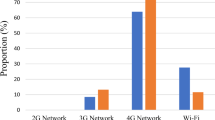Abstract
The purpose of this study is to assess the mean RF power radiated by mobile telephones during voice calls in 3G VoIP (Voice over Internet Protocol) using an application well known to mobile Internet users, and to compare it with the mean power radiated during voice calls in 3G VoCS (Voice over Circuit Switch) on a traditional network. Knowing that the specific absorption rate (SAR) is proportional to the mean radiated power, the user's exposure could be clearly identified at the same time. Three 3G (High Speed Packet Access) smartphones from three different manufacturers, all dual-band for GSM (900 MHz, 1800 MHz) and dual-band for UMTS (900 MHz, 1950 MHz), were used between 28 July and 04 August 2011 in Paris (France) to make 220 two-minute calls on a mobile telephone network with national coverage. The places where the calls were made were selected in such a way as to describe the whole range of usage situations of the mobile telephone. The measuring equipment, called “SYRPOM”, recorded the radiation power levels and the frequency bands used during the calls with a sampling rate of 20,000 per second. In the framework of this study, the mean normalised power radiated by a telephone in 3G VoIP calls was evaluated at 0.75% maximum power of the smartphone, compared with 0.22% in 3G VoCS calls. The very low average power levels associated with use of 3G devices with VoIP or VoCS support the view that RF exposure resulting from their use is far from exceeding the basic restrictions of current exposure limits in terms of SAR.
This is a preview of subscription content, access via your institution
Access options
Subscribe to this journal
Receive 6 print issues and online access
$259.00 per year
only $43.17 per issue
Buy this article
- Purchase on Springer Link
- Instant access to full article PDF
Prices may be subject to local taxes which are calculated during checkout






Similar content being viewed by others
References
Wiart J, Dale C, Bosisio AV, Le Cornec A . Analysis of the influence of the power control and discontinuous transmission on RF exposure with GSM mobile phones. IEEE Trans Electromagn Compat 2000: 62: 376–385.
Lönn S, Forssen U, Vecchia P, Ahlbom A, Feychting M . Output power levels from mobile phones in different geographical areas; implications for exposure assessment. Occup Environ Med 2004: 61: 769–772.
Hillert L, Ahlbom A, Neasham D, Feychting M, Jarüp L, Navin R et al. Call-related factors influencing output power from mobile phones. J Expo Anal Environ Epidemiol 2006; 16: 507–514.
Morrissey JJ . Radio frequency exposure in mobile phones users: Implications for exposure assessment in epidemiological studies. Radiat Prot Dosimetry 2007: 123: 490–497.
Erdreich LS, Van Kerkove MD, Scrafford C, Barraj L, McNeely M, Shum M et al. Factors that influence RF power output of GSM mobile phones. Radiat Research 2007: 168: 253–261.
Vrijheid M, Mann S, Vecchia P, Wiart J, Taki M, Ardoino L et al. Determinants of mobile phone output power in a multinational study: implications for exposure assessment. Occup Environ Med 2009: 66: 664–671.
Gati A, Hadjem A, Wong M-F, Wiart J . Exposure induced by WCDMA mobiles phones in operating networks. IEEE Trans Wireless Commun 2009: 8: 5723–5727.
Gati A, Conil E, Wong M, Wiart J . Duality between uplink local and downlink whole-body exposures in operating networks. IEEE Trans Electromagn Compat 2010: 52: 829–836.
Kelsh MA, Shum M, Sheppard AR, McNeely M, Kuster N, Lau E et al. Measured radiofrequency exposure during various mobile-phone use scenarios. Journal of Exp. Science and Environ Epidemio 2011: 21: 343–354.
Persson T, Törnevik C, Larsson L-E, Lovén J . Output power distributions of terminals in a 3G mobile communication network. Bioelectromagnetics 2012: 33: 320–325.
Picard D, Fouquet L, Chauvin S . Assessment of real exposure to gsm mobile telephones using the syrpom. Radiat Prot Dosimetry 2013: 157: 22–35.
Kühn S, Kuster N . Field Evaluation of the Human exposure from multiband, multisystem mobile phones. IEEE Trans Electromagn Compat 2013: 55: 275–287.
Picard D, Jovanovic D, Fouquet L, Chauvin S . A new high performances sarmeter [poster]. BEMS 2012.
Author information
Authors and Affiliations
Corresponding author
Ethics declarations
Competing interests
The authors declare no conflict of interest.
Rights and permissions
About this article
Cite this article
Jovanovic, D., Bragard, G., Picard, D. et al. Mobile telephones: A comparison of radiated power between 3G VoIP calls and 3G VoCS calls. J Expo Sci Environ Epidemiol 25, 80–83 (2015). https://doi.org/10.1038/jes.2014.74
Received:
Revised:
Accepted:
Published:
Issue Date:
DOI: https://doi.org/10.1038/jes.2014.74



